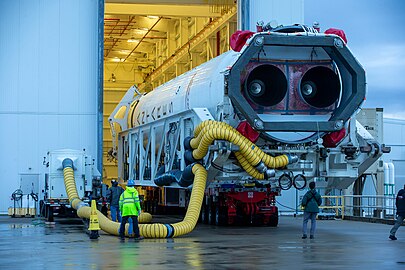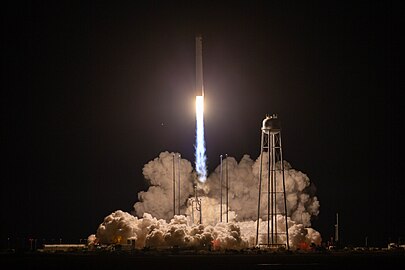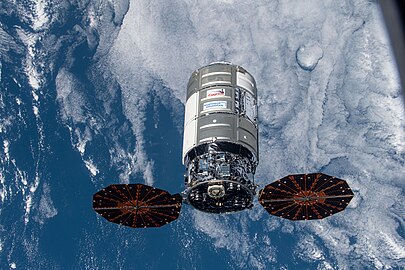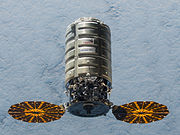 Canadarm2 approaches the S.S. Kalpana Chawla Canadarm2 approaches the S.S. Kalpana Chawla | |
| Names | CRS NG-14 CRS OA-14 (2016–2018) |
|---|---|
| Mission type | ISS resupply |
| Operator | Northrop Grumman |
| COSPAR ID | 2020-069A |
| SATCAT no. | 46530 |
| Website | NG-14 |
| Mission duration | 115 days, 19 hours, 6 minutes |
| Spacecraft properties | |
| Spacecraft | S.S. Kalpana Chawla |
| Spacecraft type | Enhanced Cygnus |
| Manufacturer |
|
| Launch mass | 7,919 kg (17,458 lb) |
| Payload mass | 3,551 kg (7,829 lb) |
| Start of mission | |
| Launch date | 3 October 2020, 01:16:14 (3 October 2020, 01:16:14) UTC (9:16:14 pm EDT) |
| Rocket | Antares 230+ |
| Launch site | MARS, Pad 0A |
| End of mission | |
| Disposal | Deorbited |
| Decay date | 26 January 2021, 20:23 (26 January 2021, 20:23) UTC |
| Orbital parameters | |
| Reference system | Geocentric orbit |
| Regime | Low Earth orbit |
| Inclination | 51.66° |
| Berthing at ISS | |
| Berthing port | Unity nadir |
| RMS capture | 5 October 2020, 09:32 UTC |
| Berthing date | 5 October 2020, 12:01 UTC |
| Unberthing date | 6 January 2021, 12:15 UTC |
| RMS release | 6 January 2021, 15:11 UTC |
| Time berthed | 93 days, 14 minutes |
 NASA insignia Commercial Resupply Services← SpaceX CRS-20SpaceX CRS-21 → Cygnus flights← NG-13NG-15 → | |
NG-14, previously known as OA-14, was the fifteenth flight of the Northrop Grumman robotic resupply spacecraft Cygnus and its fourteenth flight to the International Space Station under the Commercial Resupply Services (CRS-1) contract with NASA. The mission was launched on 3 October 2020, at 01:16:14 UTC.
Orbital ATK (now Northrop Grumman Innovation Systems) and NASA jointly developed a new space transportation system to provide commercial cargo resupply services to the International Space Station (ISS). Under the Commercial Orbital Transportation Services (COTS) program, Orbital ATK designed, acquired, built, and assembled these components: Antares, a medium-class launch vehicle; Cygnus, an advanced spacecraft using a Pressurized Cargo Module (PCM) provided by industrial partner Thales Alenia Space, Turin, Italy and a Service Module based on the Orbital Sciences' (headquartered at Dulles, Virginia) GEOStar satellite bus.
History
Cygnus NG-14 was the third Cygnus mission under the Commercial Resupply Services-2 (CRS-2) contract. Production and integration of Cygnus spacecraft are performed in Dulles, Virginia. The Cygnus service module is mated with the pressurized cargo module at the launch site, and mission operations are conducted from control centers in Dulles, Virginia and Houston, Texas.
Spacecraft
Main article: Cygnus (spacecraft)This was the ninth flight of the Enhanced Cygnus. The NG-14 Cygnus was named the "S.S. Kalpana Chawla", in memory of the NASA mission specialist who died with her six crewmates aboard the Space Shuttle Columbia (STS-107) in 2003. "It is the company's tradition to name each Cygnus after an individual who has played a pivotal role in human spaceflight", Northrop Grumman said in a statement released on 8 September 2020. "Chawla was selected in honor of her prominent place in history as the first woman of Indian descent to go to space".
Manifest
Cygnus NG-14 cargo loading began on 9 September 2020 with the NASA Glenn Research Center SAFFIRE V experiment module. The initial cargo load began two days later. Mating of Cygnus with the Antares launch vehicle occurred about a week later, with "Late Cargo Load" items on 22 September 2020. The bullet-like payload fairing was installed atop Antares on 23 September 2020. The ISS National Laboratory, created a three minute video to highlight the payloads being launched to ISS via the Cygnus NG-14 mission.
The Cygnus NG-14 spacecraft was the second heaviest cargo mission to date, loaded with 3,551 kg (7,829 lb) of research, hardware, and crew supplies:
- Crew supplies: 850 kg (1,870 lb)
- Science investigations: 1,217 kg (2,683 lb)
- Spacewalk equipment: 151 kg (333 lb)
- Vehicle hardware: 1,230 kg (2,710 lb)
- Computer resources: 71 kg (157 lb)
Two nitrogen tanks were added to this Cygnus manifest. These tanks help maintain the nitrogen component of the ISS air mixture, necessary due to a recent increase in air leakage.
Hardware
Felix & Paul Studios EVA Camera was the world's first space-rated 3D-390° virtual reality (VR) camera. The camera was designed to shoot footage for Space Explorers: The ISS Experience, a collaboration between Montreal-based Felix & Paul Studios, Time, and Nanoracks. U.S. space services company Nanoracks ruggedized the camera to survive the harsh environment of space and meet NASA requirements. NASA Astronauts will mount the camera on the Nanoracks Kaber Microsatellite Deployer inside the International Space Station (ISS) before deploying it outside to capture footage of the Earth, the ISS, and spacewalking astronauts in 8K VR for the first time.
Universal Waste Management System, a US$23 million titanium upgraded toilet, allowing astronauts to test its functionality before a similar commode flies on the Orion crew capsule to the Moon. The new toilet is roughly the size of a camper commode. It is about 65% smaller and 40% lighter than the toilet currently on the space station, according to Melissa McKinley, logistics reduction manager for the advanced exploration systems division of NASA. NASA partnered with Collins Aerospace to develop the new toilet, which officials said is better suited for female crew members than the existing commode on the station. Engineers made parts of the toilet out of titanium to withstand acid used to pre-treat urine before the fluid is recycled back into drinking water for the astronauts, said Jim Fuller, project manager of the toilet at Collins Aerospace.
Research
ELaNa 31, Educational Launch of Nanosatellites, deployed the following CubeSats from ISS: Bobcat-1, NEUTRON-1, and SPOC.
Multi-Needle Langmuir Probe (m-NLP) instrument from the University of Oslo and the Norwegian company Eidsvoll Electronics to measure ionospheric plasma densities. With its relatively low orbit, the International Space Station (ISS) passes near the peak plasma density of the ionosphere. The m-NLP is currently the only instrument in existence capable of resolving ionospheric plasma density variations at spatial scales below one-meter. m-NLP will be the first payload to be installed on the Bartolomeo platform outside the European Columbus module.
SAFFIRE V, the Spacecraft Fire Experiment, flying its fifth (and second-to-last) mission, provided by NASA's Glenn Research Center (GRC) in Cleveland, Ohio, safely examined the process of combustion, smoke behavior and flame-spreading in the microgravity environment. The last two SAFFIREs were planned to run at much lower pressures of around 8.2 psi and a 34% oxygen level. These represent significantly higher atmospheric conditions than are found here on Earth, which was expected to increase the energetic vigor of their respective flames. The first SAFFIRE experiment failed to ignite as planned, and the second returned an anomalous temperature spike reading from one of its thermocouples. David L. Urban, Ph.D. of the NASA Glenn Research Center in Cleveland, Ohio is the principal investigator for this experiment series.
Advanced Night Repair, the cosmetics company Estée Lauder flew 10 bottles of its "Advanced Night Repair" serum to the ISS, where the bottles will be photographed with Earth as a backdrop. Estée Lauder says it will use the images in social media and marketing campaigns, and then plans to auction the serum returned to Earth, with the proceeds going to charity. It is part of a new NASA program that dedicates 5% of space station cargo capacity and crew time to commercial marketing activities. Estée Lauder will reimburse NASA around US$128,000 for the resources used in the night serum marketing initiative, according to Phil McAlister, director of commercial spaceflight development of NASA.
SharkSat, a Northrop Grumman technology experiment mounted to the S.S. Kalpana Chawla. According to a NASA fact sheet, SharkSat will remain attached to the Cygnus spacecraft to demonstrate a Ka-band Software Defined Radio (SDR) system, which have applications in 5G telecommunications, satellite communications, radar, and autonomous and cognitive systems, according to NASA.
Gallery
Cygnus NG-14-
 Antares rolling to the pad
Antares rolling to the pad
-
 Launch of Cygnus NG-14
Launch of Cygnus NG-14
-
 Cygnus approaching the ISS
Cygnus approaching the ISS
-
 Cygnus berthed to the ISS
Cygnus berthed to the ISS
See also
References
- Clark, Stephen (2 October 2020). "Live coverage: Antares rocket successfully launches from Virginia". Spaceflight Now. Retrieved 3 October 2020.
- ^ "Launch Schedule". Spaceflight Now. 27 September 2020. Retrieved 2 October 2020.
- "Cygnus NG-14 Mission Page". Northrop Grumman. 26 January 2021. Retrieved 26 January 2021.
- McDowell, Jonathan C. (25 January 2021). "Space Report No. 788". Jonathan's Space Report.
- ^ Clark, Stephen (6 January 2021). "Northrop Grumman cargo ship concludes three-month stay at space station". Spaceflight Now. Retrieved 6 January 2021.
- Clark, Stephen (1 October 2020). "Northrop Grumman "optimistic" to receive more NASA cargo mission orders". Spaceflight Now. Retrieved 1 October 2020.
- Erwin, Sandra (5 June 2018). "Acquisition of Orbital ATK approved, company renamed Northrop Grumman Innovation Systems". SpaceNews. Retrieved 23 July 2018.
- ^ "Cygnus Fact Sheet" (PDF). Northrop Grumman. 2020. Retrieved 24 November 2022.
- ^ "Cygnus Spacecraft". Northrop Grumman. 6 January 2020. Retrieved 9 April 2020.
- Gebhardt, Chris (1 June 2018). "Orbital ATK looks ahead to CRS-2 Cygnus flights, Antares on the commercial market". NASASpaceFlight.com. Retrieved 2 June 2018.
- Leone, Dan (17 August 2015). "NASA Orders Two More ISS Cargo Missions From Orbital ATK". SpaceNews. Retrieved 17 August 2015.
- Pearlman, Robert Z. (9 September 2020). "Cargo spacecraft named for fallen NASA astronaut Kalpana Chawla". Space.com.
- ISS National Lab Mission Overview: Northrop Grumman NG-14 (Television production). ISS National Laboratory. 23 September 2020. Retrieved 30 September 2020.
 This article incorporates text from this source, which is in the public domain.
This article incorporates text from this source, which is in the public domain.
- Evans, Ben (16 August 2020). "Second Heaviest Cygnus, Antares Booster Processing Ramps Up for NG-14 mission". AmericaSpace. Retrieved 18 September 2020.
- ^ Clark, Stephen (3 October 2020). "Antares rocket takes aim on space station with zero-gravity toilet, other supplies". Spaceflight Now. Retrieved 3 October 2020.
- Wall, Mike (5 October 2020). "Cygnus freighter delivers space toilet and more to astronauts on space station". Space.com. Retrieved 5 October 2020.
- Wall, Mike (29 September 2020). "Small air leak on space station traced to Russian service module". Space.com. Retrieved 5 October 2020.
- Chagnon, Mikael (5 October 2020). "Partnerships: Felix & Paul Studios". ISS National Laboratory. Retrieved 17 November 2020.
 This article incorporates text from this source, which is in the public domain.
This article incorporates text from this source, which is in the public domain.
- "Space Explorers: The ISS Experience". Time Studios. Retrieved 17 November 2020.
- "Felix & Paul Studios and TIME Studios Partner with Nanoracks to Deliver Customized Space Camera to the International Space Station". Nanoracks. 5 October 2020. Retrieved 17 November 2020.
- ""ISS Experience" to bring public onto and outside space station in VR". collectSPACE. 28 January 2019. Retrieved 31 October 2020.
- Clark, Stephen (5 October 2020). "Cygnus supply ship reaches space station with titanium toilet". Spaceflight Now. Retrieved 5 October 2020.
- "Upcoming ELaNa CubeSat Launches". NASA. 10 August 2020. Retrieved 10 October 2020.
 This article incorporates text from this source, which is in the public domain.
This article incorporates text from this source, which is in the public domain.
- "ESA and Airbus sign contract for Bartolomeo platform on the International Space Station". SpaceDaily. 24 January 2020. Retrieved 27 September 2020.
- "Hot surprise on the space transporter CYGNUS". Center of Applied Space Technology and Microgravity (ZARM). 8 January 2021. Retrieved 26 January 2021.
- Ruff, Gary. "Spacecraft Fire Experiment-V". NASA. Retrieved 18 September 2020.
 This article incorporates text from this source, which is in the public domain.
This article incorporates text from this source, which is in the public domain.
External links
- Spacecraft Fire Experiment-V mission page
- Phage Evolution misson page
- OsteoOmics mission page
- Mochii mission page
- Mobile SpaceLab mission page
- Small Satellite Missions, NASA mission page Archived 24 March 2019 at the Wayback Machine
| Cygnus spacecraft | ||
|---|---|---|
| Launch vehicles |  | |
| Operators | ||
| Past missions |
| |
| Current missions |
| |
| Future missions | ||
| ||
| Uncrewed spaceflights to the International Space Station | ||
|---|---|---|
| ||
| 2000–2004 |  | |
| 2005–2009 | ||
| 2010–2014 | ||
| 2015–2019 | ||
| 2020–2024 | ||
| Future | ||
| Spacecraft | ||
| ||